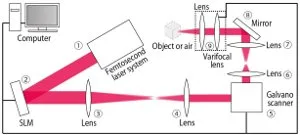A team composed of researchers from several universities and a corporation and led by Yoichi Ochiai, an Assistant Professor in the Digital Nature Group at the University of Tsukuba (Tsukuba, Japan), is developing a volumetric imaging device based on the use of femtosecond lasers.

Drawing upon an icon of pop culture, the system developed by the team can currently produce a simplified and miniaturized graphical image that is much like that presented by R2-D2 of Princess Leia in Star Wars.
The most recent results reported by the team appear in an article entitled “Fairy Lights in Femtoseconds: Aerial and Volumetric Graphics Rendered by Focused Femtosecond Laser Combined with Computational Holographic Fields”. A copy of this article can be found online here.
In the system developed by the team, a high-intensity femtosecond laser excites physical matter to emit light at an arbitrary 3D position. In one configuration, the laser produces an aerial image by inducing plasma emission in the air. From an observer’s point of view, the aerial image seems to hang in space.
The article discusses two methods of producing such an aerial image.
The first method produces holograms using spatial light modulation technology. The mechanism used to produce the images is illustrated in the figure below.
The workspace produced by the proposed system occupies a volume of about 1 cm3.
The second method uses a laser beam that is scanned by a galvano mirror. The workspace produced by this proposed system occupies a volume of up to about 5 cm3.
The researchers point out that these volumes are scalable and depend on the details of the optical devices and specific configuration of the system.
Two laser sources were tested.
The pulse duration of the first was adjustable in the range of from 30 fs to 100 fs. This laser was used to project up to 1,000 pulses per second at energy up to 7 mJ per pulse. The spatiotemporal resolution of this volumetric display was found to be 4,000 dots per second.
The pulse duration of the second was fixed at 269 fs. This laser was used to project up to 200,000 pulses per second at an energy up to 50 uJ per pulse. The spatiotemporal resolution of this volumetric display was found to be 200,000 dots per second.
Based on these performance specifications, it becomes possible to consider use of a system of this type for a variety of commercial applications. A significant enabling factor in making this claim is that a plasma induced by a femtosecond laser is much safer than that generated by prior art nanosecond lasers.
Several videos showing the Fairy Lights Holographic Display in operation are available online. One of these videos is appended at the end of this article.
Beyond aerial images, the recent article also discusses other emission techniques and rendering principles. This includes fluorescence and microbubble cavitation in solid and liquid materials.
Though still in the development phase and requiring a physically large apparatus to produce a very small image, the system does work. It should follow that the system is practical and has real potential for further development and commercial viability. – Arthur Berman
Yoichi Ochiai, University of Tsukuba, +81-3-5770-2666, [email protected]

